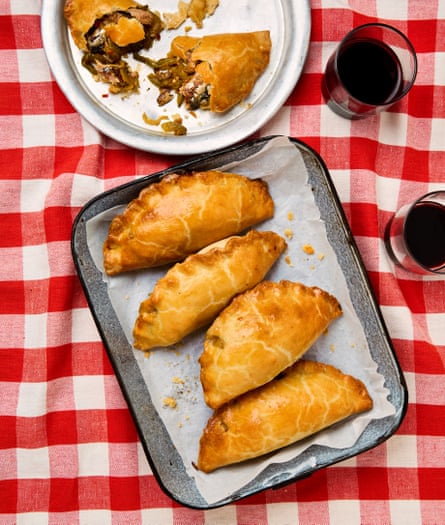Peppers are more than just staples of the Spanish kitchen, they are one of our culinary foundations. As with tomatoes, when Columbus returned from the Americas in the late 15th century, he presented peppers as a gift to Queen Isabella and King Ferdinand, and they very quickly became a key part of our cooking traditions. The pepper’s most iconic contribution to Spanish cuisine is surely pimentón de la Vera, or smoked paprika, which is an essential seasoning in a lot of Spanish cooking, adding exquisite depth to stews, rice dishes, seafood and, of course, chorizo. But we also celebrate fresh peppers in all their guises. Padrón peppers are, of course, a classic tapa, while pimientos rellenos (stuffed peppers) are filled every which way, from seafood and minced meat to creamy bechamel. From the royal court to home kitchens, peppers have taken root in our culinary culture.
Pimentos rellenos (green peppers stuffed with slow-cooked ragu – pictured top)
Stuffed piquillo peppers have long been popular in restaurants and homes across Spain, and are often filled with oxtail or bacalao. This dish provides a similar comforting experience, maintaining the essence of the traditional classic while at the same time being a bit more accessible, making it perfect for home cooking. Serve with a lovely glass of bobal, a wine from a grape variety common in Valencia and Utiel-Requena. Its richness will complement the bold flavours of the stuffed peppers. You can make the ragu in advance and freeze it, then defrost and pick things up again from the last paragraph.
Prep 15 min
Cook 2 hr 40 min+
Makes 8
3 tbsp olive oil, plus extra for drizzling
1 large onion, peeled and finely chopped
2 celery stalks, trimmed and finely chopped
2 garlic cloves, peeled and crushed
200g cooking chorizo, skinned and finely chopped
500g pork mince
1 star anise
Finely grated zest of 1 lemon
200ml white wine
400g tin tomatoes
2 tbsp tomato puree
350ml chicken stock
Flaky sea salt and black pepper
8 large green bell peppers
Heat the oil in a large saute pan, then gently fry the onion and celery for 10 minutes, until really soft. Add the garlic and chorizo and cook for a further five minutes, until the chorizo releases all its oils.
Add the pork mince, turn up the heat and brown all over, breaking up the mince with a spoon so it doesn’t clump. Stir in the star anise, lemon zest and white wine, leave to bubble for a few minutes, then tip in the tomatoes, tomato puree and stock. Season well, bring to a boil, then turn down the heat to a simmer and leave to cook, stirring occasionally, for two to three hours; add a splash more stock or water if the ragu threatens to reduce too far and dry out.
Half an hour before you want to serve, heat the oven to 200C (180C fan)/390F/gas 6. Cut the tops off the peppers and carefully remove and discard the pith and seeds with a spoon. Arrange the peppers in a roasting tin in which they will fit quite snugly, drizzle with olive oil and season well, then roast for 15–20 minutes, until soft but still holding their shape. Fill the roast peppers with the ragu, then roast for another 15 minutes. Serve hot.
Green pepper and sardine empanadas

Empanadas should be much more popular than they are, which makes me wonder if people tend to think of them as pasties, which are larger, made with shortcrust pastry that’s often high in saturated fats, filled with starchy vegetables, and often mass-produced containing additives and high in salt. Empanadas, however, are a versatile and healthier option. They’re made with a lighter, thinner dough, have less fat, are more often than not baked, and have a crisper texture. They’re typically smaller than pasties, and use a variety of lighter, tasty fillings including vegetarian, vegan and some internationally inspired alternatives. These ones are made with tinned sardine fillets, but fresh or even mussels would work well, too. Serve with a glass of chilled albariño or a crisp, cold beer.
Prep 15 min
Chill 30 min+
Cook 1 hr 30
Makes 6
2 tbsp olive oil
2 banana shallots, peeled and finely sliced
4 green peppers (long ones, if you can find them), stalks, seeds and pith discarded, flesh sliced
½ tsp chilli flakes
1 bay leaf
4 sprigs fresh thyme, leaves stripped
Flaky sea salt and black pepper
2 tbsp Pedro Ximénez sherry vinegar
12 tinned sardine fillets, drained
For the pastry
250g plain flour, plus extra for dusting
½ tsp fine salt
100g cold unsalted butter, cubed
1 egg, beaten
1 tsp white-wine vinegar
Heat the oil in a large pan, then fry the shallots for five minutes. Add the peppers, chilli flakes, bay leaf and thyme, season and cook, stirring occasionally, for 30 minutes, until lovely and soft. Add the PX vinegar, cook for a few more minutes, then take off the heat and leave to cool.
To make the pastry, tip the flour and salt into a bowl, then rub in the cold diced butter with your fingertips until the mix resembles breadcrumbs. Mix half the beaten egg with two tablespoons of cold water and the vinegar, add to the flour bowl and mix in quickly. Bring the dough together with your hands, then knead very briefly on a floured surface until smooth. Shape into a disc, wrap and chill for at least 30 minutes.
Heat the oven to 200C (180C fan)/390F/gas 6 and line a baking sheet with greaseproof paper. Divide the chilled dough into six equal-sized pieces and roll each one into a ball. Roll out each ball into a large disc, then use a pastry cutter or small plate to cut out a 16cm circle; discard any trimmings, or save for another use.

Divide the pepper mixture evenly between the pastry circles, leaving a border all around the edge, then top each one with two sardine fillets. Brush the edges with beaten egg, fold the pastry over the top of the filling and pinch and crimp the edges together.
Transfer to the lined baking sheet and brush all over with the remaining beaten egg. Bake for 20–25 minutes, until golden brown, then serve warm or at room temperature.
-
These recipes are edited extracts from The Spanish Pantry: 12 Ingredients, 100 Simple Recipes, by José Pizarro, published this week by Quadrille at £28. To order a copy for £25.20, go the guardianbookshop.com

.png) 2 months ago
32
2 months ago
32

















































